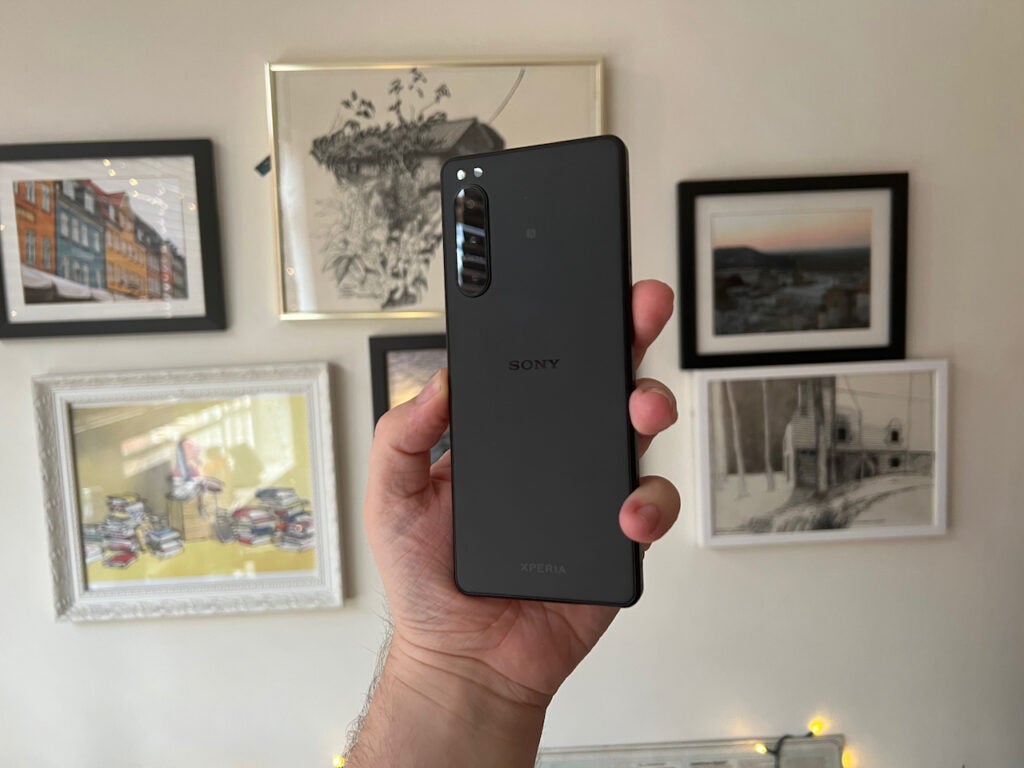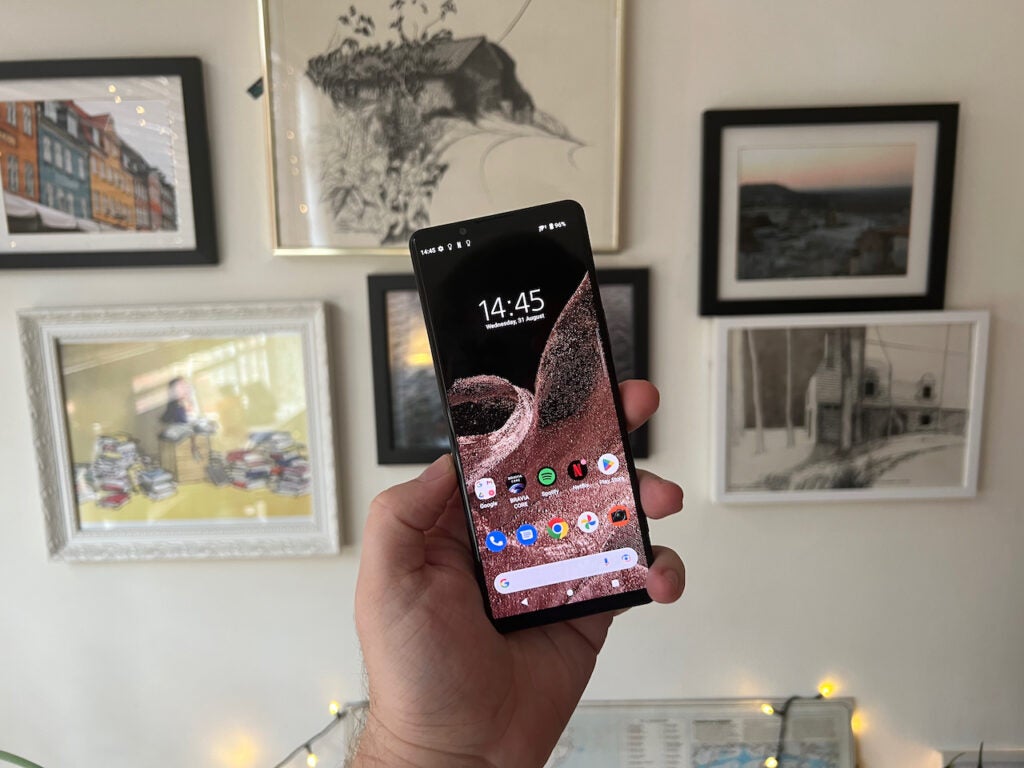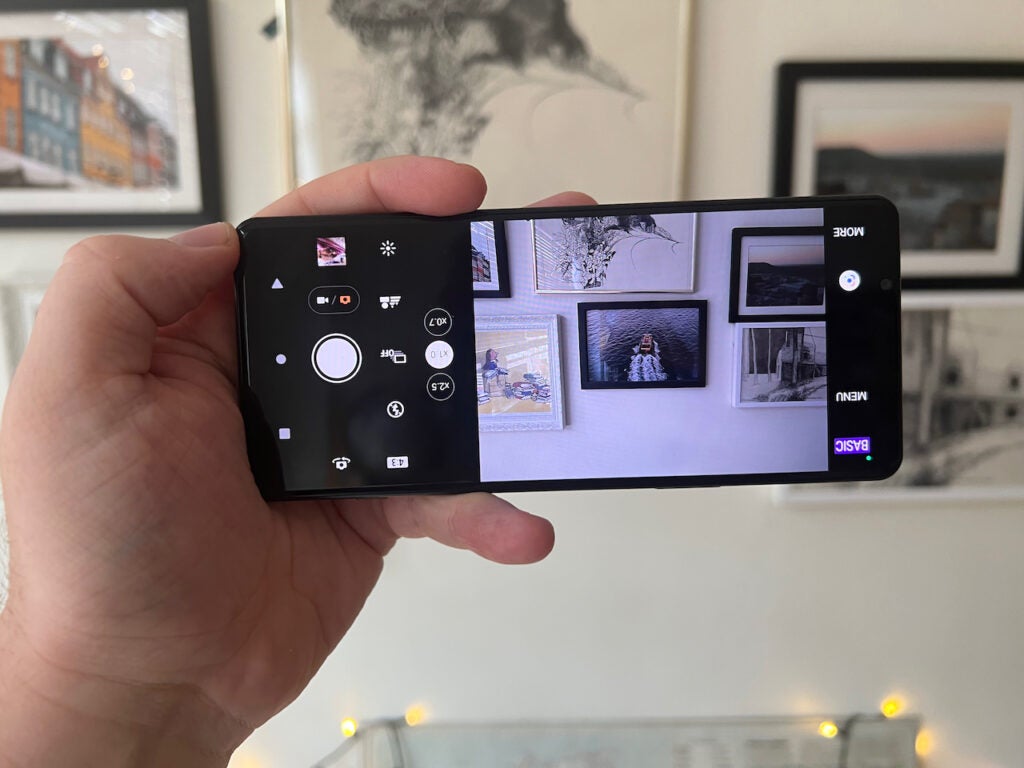There’s a lot to like with the Sony Xperia 5 IV. It retains features, like expandable storage and a capable headphone port, that are often ditched elsewhere, while the smaller size helps to set it apart from the larger competition. But the camera is underwhelming and the phone is extremely expensive at over €1000.
-
Immersive display6.1-inch, 21:9 OLED screen is free of a notch and more immersive as a result -
Triple camera arrayThree rear 12MP cameras, including wide, ultra wide and tele -
Top specsSnapdragon 8 Gen 1 chip, 8GB RAM and 5000mAh battery
Introduction
Sony has just announced the Xperia 5 IV and I have had my hands on the new device for the last few days. While that isn’t enough time for a full review, it is enough for a few initial thoughts.
The fourth iteration of the Xperia 5 joins the Xperia 1 IV at the top of Sony’s Android smartphone range, offering many of the same features in a smaller package.
This isn’t a mid-range phone though – instead its price and spec list put it right up against the Galaxy S22 Plus. It is cheaper than the Xperia 1 IV, but will still retail for €1049 (roughly $1049, £900).
Design and Screen
- Tall, narrow display
- Excellent OLED panel
- SD expansion, camera shutter button and headphone jack
Sony might no longer refer to these phones as ‘Compact’ devices, but the Xperia 5 series has always targeted those who prefer a smaller device. The tall, narrow design used here – paired with a 6.1-inch display – makes for a phone that feels nicer to hold than the very wide iPhone 13 Pro Max. I don’t have overly large hands, but I can still hold this phone and navigate the majority of the display with one hand,
Visually, the phone carries many of the design traits highlighted by Sony’s recent Xperia 1 IV. This is a subtle device, with flat sides, a fingerprint-resistant matte finish on the back and an IP68 water resistance rating. There’s a very fast and reliable fingerprint sensor embedded inside the power button and a two-step shutter button next to it.
The addition of that camera shutter button, something which has become a staple of these Sony phones, signifies an important trend. This is a phone that keeps around features often ditched by other flagship phones.
For instance, there’s a Hi-Res Audio capable 3.5mm headphone jack on the top and a Micro SD card slot tucked inside a SIM slot that doesn’t require a fiddly tool to open. The display is also completely free of any notches or cutouts, giving you an immersive view.

It’s nice to see these features stick about, and it gives the Xperia 5 IV something a niche appeal to those who feel flagships like the Galaxy S22 Plus miss out on too many important touches.
The display itself doesn’t have the same 4K resolution as the pricier Xperia 1 IV, though considering I am yet to be fully convinced so many pixels are necessary on a smaller display, I don’t think it’s a big deal. The 1080p (or FHD+) panel here is sharp, while the OLED tech offers deep blacks and punchy contrast. There’s also good HDR support, with supported titles on Netflix packing some extra punch.
Sony claims the 5 IV offers 50% more brightness than the previous model, and while I haven’t spent enough time to properly judge that claim I have been easily able to use the phone in brighter conditions.
While the display does support a fast and smoother 120Hz refresh rate, it’s not an adaptive display meaning it’ll stick to that 120Hz rate until you manually switch it back to 60Hz. This feels like a disappointing omission, as you’ll find this feature on all the best phones around.
Even though the 6.1-inch screen is smaller than many other Android phones, it remains an excellent phone for watching media and playing games. The tall 21:9 aspect ratio is great for films (though not as good for 16:9 TV shows and YouTube videos), while the speakers pump out very good audio. There are a number of Game Enhancer features in the software, including built-in live streaming.

Specs and Performance
- Snapdragon chipset, 8GB RAM and 128GB storage
- Wireless charging, 5000mAh battery
- 3 x 12MP rear cameras
The three rear cameras and an up updated selfie shooter are the focus of the Xperia 5 IV. All three rear 12MP cameras are capable of recording 120fps HDR video in 4K and there are both Photo Pro and Videography Pro apps for delving in and tweaking settings. Impressive Eye AF remains for stills and now video, while the burst shooting mode has received a significant boost.
I’ve not spent enough time to deliver a final verdict on the camera skills here and that will come in our full review.
The 12MP selfie camera consists of a larger sensor than was in the previous model, hopefully drawing in more light and producing better low-light snaps.

To go along with the Photo and Videography Pro apps, there’s also Music Pro – a software-based music studio that allows you to record vocals and instruments.
Powering the phone is the Snapdragon 8 Gen 1 chipset – not the 8 Plus Gen 1 chip found in recent devices like the OnePlus 10T and Galaxy Z Flip 4. Considering the price of this device, it’s a shame Sony couldn’t have included the latest chip. 8GB RAM and 128GB of storage come as standard, as does a large 5000mAh that supports wireless charging.
Don’t expect to find a charger in the box though, and Sony doesn’t even provide a charging cable. The box is completely plastic free, and basically just includes the phone and nothing else.
First Impressions
There’s a lot to like with the Sony Xperia 5 IV. It retains features, like expandable storage and a capable headphone port, that are often ditched elsewhere and the smaller size help set it apart from the larger competition.
Yet, our reviewer didn’t always enjoy the camera on Xperia I IV and the majority of that tech is here – so there’s every chance this won’t be one of the best camera phones around. It’s also very expensive, coming in at over €1000.
Jargon buster
OLED
Organic Light Emitting Diode is panel technology that allows each individual pixel to produce light rather than relying on a backlight. This enables the screen to accurately display blacks by turning off the pixel, resulting in improved contrast compared to conventional LCD panels.
mAh
An abbreviation for milliampere-hour and a way to express the capacity of batteries, especially smaller ones in phones. In most cases the higher the mAh, the longer the battery will last but this isn’t always the case.
















